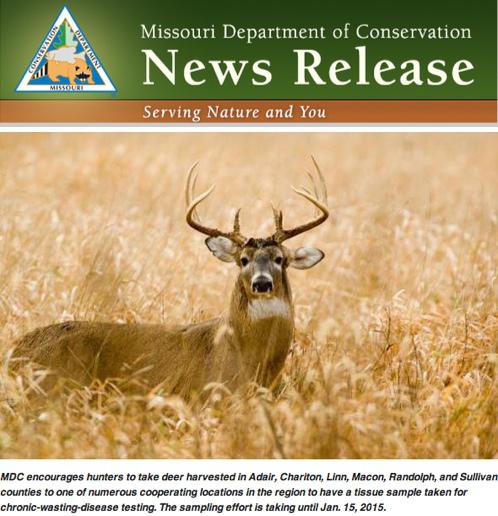
“Conservation makes Missouri a great place to hunt deer, and deer hunters are key to keeping it that way,” says MDC Deer Biologist Jason Sumners. “Because many hunters process their own deer, they are key players in slowing the spread of diseases such as CWD. One way that disease can spread is by the transportation and improper disposal of carcass parts.”
Deer can become infected with chronic wasting disease if they come into contact with other infected deer or with surface soil containing carcass parts from diseased deer. Deer carcass parts known to concentrate CWD include brain, spinal cord, eyes, spleen, and lymph nodes.
Chronic wasting disease was first found in Missouri in Macon and Linn counties several years ago. In response, MDC established a CWD Containment Zone covering Adair, Chariton, Linn, Macon, Randolph, and Sullivan counties. The disease remains limited to the local area.
“Hunters who harvest deer in these counties should not take whole deer carcasses out of the containment zone, or carcass parts that contain brain, spinal cord, eyes, spleen, or lymph nodes,” Sumners adds, along with the following information.
Proper Carcass Disposal
Avoid cutting through bones, spine, or brain when processing deer carcasses.
Remove meat in the field and leave the carcass behind. Bury it if possible.
If processing harvested deer in camp or at home, place carcass parts in trash bags and properly dispose of them through a trash service or landfill.
Take harvested deer to a licensed commercial processor to assure proper carcass disposal.
For taxidermy work, use a licensed taxidermist to assure proper carcass disposal.
Safe Parts to Transport
Meat that is cut and wrapped, or has been boned out,
Quarters or other portions of meat with no part of the spine or head attached,
Hides or capes from which all excess tissue has been removed,
Antlers, including antlers attached to skull plates or skulls cleaned of all muscle and brain tissue, and
Finished taxidermy products.
The Wildlife Code of Missouri requires hunters who harvest deer, elk, or moose out of state and bring the animal with the spinal column or head attached into Missouri to call toll free, 877-853-5665, and report the animal’s entry within 24 hours. They also must take the carcass to a licensed meat processor or taxidermist within 72 hours of entry. This is designed to prevent introducing CWD into new areas of Missouri from other states. Hunters transporting deer through Missouri en route to other states do not need to call the number.
Donate Tissue Samples
Sumners also encourages hunters who harvest deer within the CWD Containment Zone of Adair, Chariton, Linn, Macon, Randolph, and Sullivan counties to donate tissue samples from their deer to the Conservation Department for its CWD monitoring program. Numerous deer-processing facilities and taxidermists in the area are participating in the effort.
Details about these measures are listed in the 2014 Fall Deer & Turkey Hunting Regulations and Information booklet, which is available at MDC offices and nature centers, where hunting permits are sold, and online at mdc.mo.gov/sites/default/files/resources/2010/03/ftd2014.pdf.

Leaves turn colors when two things happen. First, sugars produced by photosynthesis are trapped inside leaves by chilly - but not freezing - autumn nights. Those sugars are the building blocks for red, yellow, orange, and purple pigments. Cool nights simultaneously cause the breakdown of green pigments, allowing these other colors to show through.
Missouri’s fall color starts in late September and usually peaks in mid-October. This progression of color change starts earliest in northern Missouri and moves southward across the state. Normally by late October, colors are fading and leaves are beginning to drop from trees. Generally, color change is predictable, but can vary year to year, depending on weather.
According to Missouri Department of Conservation Forestry Field Program Supervisor Nick Kuhn, autumn weather will be the biggest factor affecting this year’s fall color.
“It has been a decent year for most trees,” says Kuhn. “Sufficient rain, moderate temperatures, no serious insect problems, or weather events means trees are happy and doing OK. The fall weather will be the major factor in showing us those wonderful hidden colors in all trees. Watch for sunny days and cool nights with no frost to know when to start looking for color changes. I predict that across the state, the best week for fall color change will be the last week of October.”
The Conservation Department provides weekly fall-color reports and has developed a free mobile app to help Missourians discover fall color around the Show-Me State. The report combines information from foresters around the state in weekly online updates at mdc.mo.gov/node/4548 from late September through November.
The Conservation Department’s free MO Fall Color application is available for smart phones and other mobile devices. It provides up-to-the-minute fall-color scenes from around the state, complete with GPS navigation information. The app also provides weekly fall-color reports for various areas of the state. Users can even add their own fall-color photos and share them with Facebook friends and others. The MO Fall Color app is active during fall-color changes beginning in September through November. Download MO Fall Color for Android and Apple devices at http://mdc.mo.gov/node/19321.

Jefferson City, Missouri - Now is a great time to purchase your hunting, fishing, and trapping permits for the fall seasons. The Missouri Department of Conservation (MDC) offers convenient ways of purchasing permits to help hunters, anglers, and trappers get to the field.
E-Permits
The Department’s e-Permit system enables hunters, anglers and trappers to purchase, print and immediately use all Missouri sport-hunting and sport-fishing permits, along with trapping permits and the Apprentice Hunter Authorization. Hunters, anglers and trappers can buy e-Permits online at mdc.mo.gov and print the paper permits 24/7 anywhere they have access to a computer and printer. Hunters, anglers and trappers can still buy permits from vendors, and by phone by calling toll-free 1-800-392-4115. Phone purchases are subject to a $2 processing fee and require up to a two-week wait time to receive the permits through U.S. mail. The fee for e-Permits is $1. There is no additional fee for permits purchased from vendors.
MO Hunting App
In addition, the Department is offering the new MO Hunting mobile application, which is available through Google Play and iTunes stores. MO Hunting enables Missouri hunters, anglers, and trappers to purchase and view annual hunting, fishing, and trapping permits, as well as view permits purchased during the previous year. The app will also allow deer and turkey hunters to telecheck their harvests directly from their related permit within the application through an easy-to-use fillable form. MO Hunting also enables hunters to view all deer and turkey which they have previously telechecked.
Duck Stamps
Duck stamps will be sold online in Missouri for the first time this year, giving hunters and retail vendors an alternative to buying/selling paper duck stamps. Hunters can buy the stamps at mo.wildlifelicense.com. The online option provides greater flexibility and convenience to waterfowl hunters. The US Fish and Wildlife Service selected Missouri, along with Louisiana, Michigan, North Carolina, and Virginia, to provide duck stamps through its federal e-Stamp option.
All Missouri permit vendors will offer electronic duck stamps, and the traditional purchase venues of the post offices, Department of Conservation offices, and nature centers will continue to carry the paper duck stamp.
Permits and duck stamps will no longer be sold at waterfowl conservation areas, except for Columbia Bottom Conservation Area. Since not all post offices or Conservation Department offices have the stamps, it’s a good idea to buy well in advance of hunting or call ahead about availability.
Retail vendors will be able to process the transaction for hunters. An electronic stamp, or e-Stamp, will be issued at the time of purchase, and a paper duck stamp will be sent through the mail.
Hunters can use their e-Stamps immediately and for 45 days following purchase. After 45 days, they must carry the paper duck stamp.
E-Stamps may be purchased from permit vendors for $17.50, which includes a $2.50 handling fee to cover the cost of processing and mailing the paper stamp. E-Stamps can also be purchased from the convenience of your home computer or mobile device for an additional $1 Internet service fee on your total online order.

Stoddard County, Missouri - Eastbound Business 60 in Stoddard County will be reduced to one lane with a twelve-foot width restriction as contractor crews build new sidewalks.
This section of roadway is located from North Poplar Street to Route 25.
Weather permitting work will be performed Monday, Sept. 22 through Friday, Oct. 3 from 7 a.m. to 5 p.m. daily.
The work zone will be marked with signs. Motorists are urged to use extreme caution while traveling near the area.
For additional information, contact Resident Engineer Audie Pulliam at (573) 840-9781 or MoDOT's Customer Service Center toll-free at 1-888-ASK-MODOT (1-888-275-6636) or visit www.modot.org/southeast

The Open House is scheduled for Friday, October 3, 2014 from 11:00 a.m. – 3:00 p.m. Informational tours of the landfill will be provided and a light lunch will be served.
Please R.S.V.P. by September 29th to Doug Ticer at 573-820-6932.
Check-out how beautiful the landfill really is and you will be surprised!

